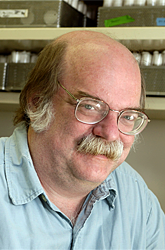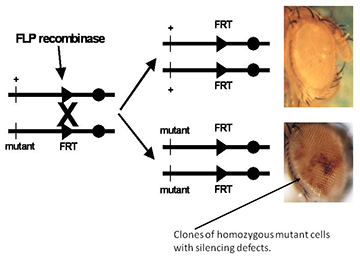You are here: Home > Section on Drosophila Gene Regulation
Genomics of Development in Drosophila

- James A. Kennison, PhD, Head, Section on Drosophila Gene Regulation
- Alexander Conant, Summer Intern
- Monica T. Cooper, BA, Senior Research Technician
- Mark Mortin, PhD, Staff Scientist
Our goal is to understand how the linear information encoded in genomic DNA functions to control cell fates during development. The Drosophila genome is about twenty times smaller than the human genome. Despite its smaller size, most developmental genes and at least half of the disease- and cancer-causing genes in man are conserved in Drosophila, making Drosophila a particularly important model system for the study of human development and disease. One of the important groups of conserved developmental genes are the homeotic genes. In Drosophila, the homeotic genes specify cell identities at both the embryonic and adult stages. The genes encode homeodomain-containing transcription factors that control cell fates by regulating the transcription of downstream target genes. The homeotic genes are expressed in precise spatial patterns that are crucial for the proper determination of cell fate. Both loss of expression and ectopic expression in the wrong tissues lead to changes in cell fate. The changes provide powerful assays for identifying the trans-acting factors that regulate the homeotic genes and the cis-acting sequences through which they act. The trans-acting factors are also conserved between Drosophila and human and have important functions, not only in development but also in stem cell maintenance and cancer.
Cis-acting sequences for transcriptional regulation of the Sex combs reduced homeotic gene

Figure 1. Chromosomal aberrations in the distal half of the Antennapedia complex
The transcription units are above the genomic DNA, while chromosomal aberrations are below (solid triangles indicate insertions of transposable elements and upward arrows indicate breakpoints of translocations and inversions). Chromosomal aberrations (shown in red) interfere with silencing in the adult second and third legs. The regions that include the proximal and distal MES are indicated by the horizontal arrows.
Assays in transgenes in Drosophila previously identified cis-acting transcriptional regulatory elements from the homeotic genes. The assays identified tissue-specific enhancer elements as well as cis-regulatory elements that are required for the maintenance of activation or repression throughout development. While these transgenic assays have been important in defining the structure of the cis-regulatory elements and identifying trans-acting factors that bind to them, their functions within the context of the endogenous genes remain poorly understood. We used a large number of existing chromosomal aberrations in the Sex combs reduced homeotic gene to investigate the functions of the cis-acting elements within the endogenous gene. The chromosomal aberrations identified an imaginal leg enhancer about 35 kb upstream of the Sex combs reduced promoter. This enhancer is not only able to activate transcription of the Sex combs reduced promoter that is 35 kb distant, but it can also activate transcription of the Sex combs reduced promoter on the homologous chromosome. Although the imaginal leg enhancer can activate transcription in all three pairs of legs, it is normally silenced in the second and third pairs of legs. The silencing requires the Polycomb group proteins. We are currently trying to identify the cis-regulatory DNA sequences in the Sex combs reduced gene that are required for transcriptional activation in the first leg and for Polycomb group silencing in the second and third legs. Characterization of the chromosomal rearrangements shown in Figure 1 also revealed that two genetic elements (proximal and distal MES) about 70 kb apart in the Sex combs reduced gene must be in cis to maintain proper repression. When not physically linked, these elements interact with elements on the homologous chromosome and cause derepression of its wild-type Sex combs reduced gene. We tested DNA fragments from the Sex combs reduced gene in transgenic assays to identify endogenous cis-regulatory elements that could interact. From the regions that include the regulatory elements required for the maintenance of silencing, we identified two clusters of DNA fragments that promote pairing-sensitive silencing (an assay for interaction of cis-regulatory DNA fragments). To assay their role in transcriptional regulation, we are using targeted gene replacement to delete the clusters of elements from the endogenous gene. We are also using these pairing-sensitive silencing elements to screen for the trans-acting factors that are required for their function.
Trans-acting activators and repressors of homeotic genes

Figure 2. Homeotic phenotypes of new pharate-adult lethal mutants
Panel A shows wild-type on the left and the transformation of aristae to distal leg on the right. Panel B shows a wild-type haltere on the left and transformations of anterior and posterior haltere to anterior and posterior wing in the middle and right, respectively. Panel C shows the first legs from a wild-type male on the left and three different mutants with reduced sex combs on the right. Panel D shows a mutant male with sex combs on both the first and second tarsal segments. Panel E shows a mutant male with sex combs on all three pairs of legs. Panel F shows, on the left, the abdominal segments from a wild-type male and, on the right, a mutant male with transformation of the fifth abdominal segment to a more anterior identity. (click image to enlarge)
The initial domains of homeotic gene repression are set by the segmentation proteins, which also divide the embryo into segments. Genetic studies have identified the trithorax group of genes that are required for expression or function (such as maintenance of transcriptional activation) of the homeotic genes. Maintenance of transcriptional repression requires the proteins encoded by the Polycomb group genes. To identify new trithorax group activators and Polycomb group repressors, we are screening for new mutations that mimic the following phenotypes: loss of function or ectopic expression of the homeotic genes. We generated over 4,000 lethal mutants and, among those that die late in development, have identified two dozen mutants with homeotic phenotypes. Some of the homeotic phenotypes are shown in Figure 2. These mutants identify genes required for expression or function of the homeotic genes. We are also using pairing-sensitive silencing elements from the Sex combs reduced gene to screen for recessive mutations that interfere with homeotic gene silencing.
Reduced function of the trithorax group genes mimics loss of function of the homeotic genes. We previously identified several trithorax group genes that encode subunits of chromatin-remodeling complexes. The brahma, moira, and osa genes encode subunits of the Brahma chromatin-remodeling complex, which is conserved from yeast to human. To understand further the function of the Brahma complex, we have been isolating and characterizing mutations that interact with brahma. One gene that we identified by its mutant interactions with brahma is rhinoceros, which encodes the Drosophila homolog of a mammalian transcription factor that interacts with the von Hippel Lindau tumor suppressor. The Brahma protein is one of seventeen SNF2-family chromatin-remodeling ATPases in Drosophila. Four of the other members of the SNF2 family in Drosophila contain chromodomains in addition to the SNF2 domain. These are the CHD-group proteins. We previously showed that two CHD-group proteins, kismet and Mi-2, are required for homeotic gene transcriptional regulation and for viability. To determine the function of Chd3, another CHD-family protein in Drosophila, we identified the essential genes in a 600 kb region of the genome surrounding Chd3. Although we identified 24 essential genes in this region, none are in the 200kb that includes the Chd3 gene, as shown in Figure 3. We deleted most of the Chd3 gene and found no affects on either viability or fertility.
Figure 3. Molecular map of the genomic region that includes Chd3
The approximately 640 kb of genomic DNA that includes the Chd3 gene is broken into three parts (A, B, and C) and is represented by the horizontal black arrows at the top of each part. The annotated transcription units are represented by colored thick horizontal arrows. The Chd3 transcription unit in Panel A is depicted in black, the essential transcription units in red, and the remaining transcription units in blue. The two regions that include the five essential genes (76BDg, 76BDh, 76BDd, 76BDj, and 76BDt) for which the transcription units have not been identified are indicated by red horizontal brackets above the candidate transcription units (Panel B). A 31.4 kb tandem duplication (distal copy and proximal copy) flanked by Doc transposable elements in the sequenced iso-1 strain (but not in other wild-type strains) is shown on the genomic DNA at the left of Panel C, with the Doc elements represented by inverted brown triangles. (click image to enlarge)
Publications
- Kassis JA, Kennison JA. Recruitment of Polycomb complexes: a role for SCM. Mol Cell Biol. 2010 30:2581-2583.
- Cooper MT, Conant AW, Kennison JA. Molecular genetic analysis of Chd3 and polytene chromosome region 76B-D in Drosophila melanogaster. Genetics 2010 185:811-822.
Collaborators
- Der-Hwa Huang, PhD, Institute of Molecular Biology, Academia Sinica, Taipei, Taiwan, ROC
- Martha Vazquez, PhD, Instituto de Biotecnología, UNAM, Cuernavaca, Mexico
- Mario Zurita, PhD, Instituto de Biotecnología, UNAM, Cuernavaca, Mexico
- Judy Kassis, PhD, Program on Genomics of Differentiation, NICHD, Bethesda, MD
Contact
For more information, email kennisoj@mail.nih.gov.



